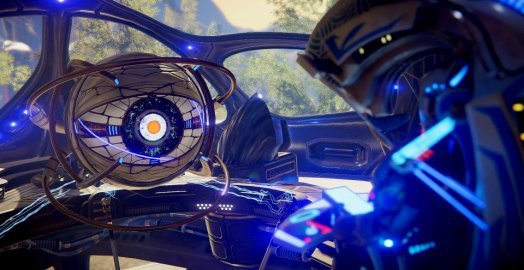Review for Lightstep Chronicles

With Artificial Intelligence (and its cousins Augmented Reality and Applied Intelligence) being at the forefront of today’s technology to help solve humanity’s problems, developer Eipix Entertainment (better known for their line of casual games) has brought to life a text-driven adventure game based on their own five-part space opera graphic novel series Lightstep on Dark Horse Comics. Lightstep Chronicles involves a number of sentient AI characters stationed aboard the starship Amarok, exploring how they deal with a terrible turn of events that will test their programming and ultimately their sanity when a human variable is introduced. There’s a lot of reading involved and it’s not particularly interactive, but it’s a highly polished, surprisingly cinematic production whose story is cleverly revealed through well-written dialog and thought-provoking response options experienced along the way.
Before you start, it is highly recommended that you read the short series of log reports on Steam that shares a bit of backstory and only takes a few minutes. Players control Captain Caine Phoenix, the leader of a salvage team whose job is to recover whatever you can from a derelict spacecraft discovered on planet Kepler 452b. The opening cut scene is visually stunning, with top-notch animations and sound but only mediocre voice acting (not to worry, as no further voice-overs occur for the rest of the game). A follow-up video of equally high quality sees your team exploring the ship and being ambushed by a malevolent drone, only to be saved by an unknown ally. You then find yourself trapped in a moving chair facing what looks like a giant robotic eye.
The gameplay begins here, with a first-person field of view that can be moved very slightly with the mouse, where your only option is to start a conversation with the robot. You soon learn that this entity named Aleph (short for Advanced Logic, Empathy, Psychology & Heuristic unit) is the one who saved you and your squad mates. This initial exchange presents a series of sentences or statements, followed by one or more options to reply on the left side of the screen. During your many (and often lengthy) conversations, not much happens visually in the center of the screen, with just a view of you sitting in your chair with limited animations in the background, which is fine since you’ll be busy reading anyway. Low, almost constant synthesized music plays pleasantly in the background, accompanied by realistic sound effects, changing to more intense melodies when appropriate.
Being a text-based adventure, I expected to do a fair bit of reading, but the dialog at times comes fast and furious, with each sentence contained in a separate box cascading downward as the current discussion unfolds. Occasionally I had difficulty keeping up (I am not the fastest of readers), but although there is no way to adjust the pace of the messages, there is a scroll bar that allows you to go back and review what has been said that proved very useful. Another handy interface feature is a drop-down list of all log files created as key information is either revealed or discovered. This also has a scroll bar that allows you to review everything written to that point, which I ended up using a fair bit to refresh my memory.
Shortly into your first conversation with Aleph, you will discover that you are actually confined to your chair, unable to escape. The reason you’re given is that it prevents you from being detected by Malkuth, described as an evil entity that will kill you the first chance he gets. Players will remain in this chair for the rest of the game (except during simulations), which I found very restrictive. Exploration is usually an important part of adventure game design, and there are ample opportunities here for you to venture into other areas of the ship if only you were able. It is also impossible to lie to Aleph (or any of the other characters you encounter) since the chair is essentially a lie detector, monitoring your blood pressure, heart rate, respiration, etc. While this can lead to failure with some of your dialog choices, the options simply revert back to the original selections to try again. This effectively limits the number of branches a conversation can take, thereby streamlining gameplay.
That’s not to say you’re limited to just sitting there and passively observing, however. Aleph will give you a brief tutorial, if requested, on how things work on the ship. Elements needed to progress appear at the bottom of the screen. The Control Mode icon at the bottom right lets you interact with the environment, and once selected you can use the Scan button to find all relevant objects. Since you can’t physically leave your chair, you need to connect to one or more of the droids floating around the room to get another perspective, and then scan again. The scan level, displayed as a percentage, lets you know you have missed something if it is less than 100%. Later you will be able to connect directly to different locations.
When you click on an interactive object, a control panel appears with several coloured diamond shapes. Clicking on the shapes will produce a unique text description of a certain function on the screen. Some can only be read, and sometimes the shapes are locked and need to be opened first, but active shapes will provide useful messages or allow you to operate a device. Occasionally a crew member log will be displayed, which are used to good effect to give you an idea of what happened to the humans who were once aboard the Amarok and provide valuable context to your discussions with the AI characters.
Aleph needs your help to recover control of the ship from its dormant state. To do this you will need to enter five access codes into the manual override console after retrieving them from other characters. Aleph mentions that the override will also delete all the rebellious, broken subsystems, which is your first clue that something is not right with the various AIs on board. After Aleph leaves to take care of a system alarm, a new AI bot arrives named Yesod, warning you not to believe everything you hear and that your life is in danger. Yesod has some interesting backstory to share, but leaves when Aleph returns and takes the ship into space, where you are treated to another excellent cut scene displaying the amazing Lightstep drive technology.
There are puzzles to be solved as well, but they are few and far between and relatively easy. The aim of the first is to find a way to divert power to the simulation chambers, which involves figuring out the correct pattern on four power bars with four segments each. The biggest challenge this posed was determining the orientation from the clue provided, but once I did it was a snap to solve. This puzzle is repeated later to activate a part of the ship. Once operational, the simulations allow you to leave your chair and become an avatar within other environments ranging from an alien world with exotic foliage and strange flying creatures, to a labyrinth of stairs, to a garden inside a dome on a spaceship. These are all beautifully rendered, but you still have no control over where you go or what to do. Your actions are all scripted, and when you talk to the AI system you see only animations of your character gesturing during the dialog.
Another puzzle involves answering a series of questions from Yesod about various planetary systems in the galaxy. The information you need is accessed via a Star Map that becomes available during the conversation. I was very impressed with the attention to detail and high resolution graphics here. There are six different systems with at least two planets each, all beautifully illustrated with extensive Astronavigation Data. In terms of difficulty, however, since you have access to the Star Map when trying to pick which answer to select, all you have to do is find the planet in question to arrive at the answer. Again very straightforward.
As you progress you will meet the other AI systems on Amarok. Hod is the personification of a nine-year-old boy. You meet him in a kind of holodeck simulation (that you first need to unlock) where he has taken the form of a creature he refers to as “Colony 66” and looks like a floating elf with a long tail. Hod has a child’s innocence and just wants to play a game; if you win you will get his master code. Tiferet is also first met via the simulation chamber. She is essentially a prostitute, often fulfilling sexual fantasies for crew members to relieve their stress and anxiety, and not unsurprisingly she has grown to despise humanity. I found Tiferet the most interesting character in the game, but you can never be sure if she can be trusted, given her past. The last AI you meet is the mighty Malkuth himself, who reveals the most details about the terrible past of the Amorok, how the different subsystems came to be, and why they distrust each other.
After talking to all these systems, eventually you need to decide if you are going to help Aleph, and your decisions one way or the other may result in death, usually in an unpleasant manner. If you do die you can simply restart from the last checkpoint as the game uses an autosave system. This leads to one of my main issues with the game: no matter what choices you make, while you get different responses (and in some cases more context to the overall plot), you are forced down the same main narrative path. Here the illusion of choice is just that – an illusion. Your decisions don’t matter. Given the many possible ways the story could have gone based on your response options, I found this very disappointing.
The game culminates with one big decision at the end, which is the only one that ultimately seems to matter much. Once you have acquired all the keys and entered them into the manual override console, you can choose from one of six options – the AI system you trust, or a System Reset. You are clearly told that whatever decision you make is final, and sure enough, once you have made your choice and see the ending, your only option to see the others is to start a new game from scratch. While the playtime is relatively short (it took me about three hours my first time through to explore all options, and my second less than two), it would take approximately ten to fifteen hours to see all the possible outcomes, and since there is very little variety each time you play, it becomes repetitive. While I experienced only two endings, it seemed clear that there is at least one “good” ending and more than one “bad” ending.
While there wasn’t enough incentive for me to keep replaying just to watch different ending cinematics, I was pleased to see that Eipix stayed true to their casual game roots by providing bonus content once you finish, including a variety of art and a 285-page Lightstep Chronicles novel, downloadable in PDF format. I have not read it yet, but given the rich writing and storytelling presented here, I expect it will be worth the time for science fiction fans.
Despite my gripes with some of the limitations in movement, challenge and consequences to your choices, Lightstep Chronicles explores the possibilities of what could happen if Artificial Intelligence becomes sentient and begins to suffer from some of the many foibles that humans experience, including madness and paranoia, and it does so in a compelling way. It’s not nearly as replayable as its many different endings would suggest, and if you’re expecting a traditional point-and-click adventure you may be disappointed, but it looks stunning and fans of interactive fiction and/or graphic novels will surely appreciate the excellent storytelling.




























